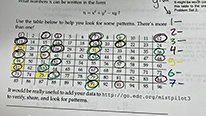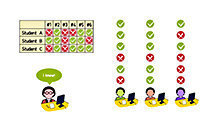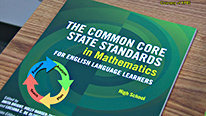NSF Awards: 1720507
The Video in the Middle NSF project's is designing, developing and researching online PD modules that can be used flexibly by mathematics educators, coaches, district math leaders and PD providers. The project is finishing its second year and has to date focused on the design and development of ~25 two-hour modules. These modules place a video clip at the center, or “in the middle,” of a professional learning experience as teachers take part in an online experience of mathematical problem solving, video analysis of classroom practice, and pedagogical reflection. The modules are designed to increase middle school math teachers’ awareness of how various representations of linear functions are linked, how students conceptualize and approach linear growth sequences, and how teaching practices can impact student understanding of linear functions.
The usability results indicated that middle grades mathematics teachers as well as teacher educators found the adapted materials useful and engaging. The results also identified ways to improve the materials. Feasibility research is currently being conducted with 24 teachers split between the three participation formats (independent, locally facilitated and VIM project facilitated). Data collection includes teacher survey, teachers’ work in the modules (journals), self-reported teaching practices via a weekly log, and mathematical knowledge for teaching through artifact analysis. These data will be inductively coded by participation format, and the results of this coding will be compared across the three formats. A randomized control trial will be conducted during 2020-2021 of 30 teachers in each participation format (90 total teachers) that will include student impact data.










Elizabeth Dyer
Research Associate
Thanks for visiting our video! We are currently in the second year of a four-year NSF DRK12 project. Up to this point, we have been focusing on designing and creating online video-based PD modules for teachers, and have gathered usability and feasibility data from math teachers and teacher educators. We’re now beginning to transition toward our research study that will examine the preliminary impact of the modules on teacher knowledge, instructional practice and student learning.
As a starting point for discussion, here are some things we've been thinking about and would love your feedback on:
We are excited to join the conversation within this community, and you can find more information about our project at www.videointhemiddle.com.
Susan Jo Russell
Principal scientist
Hi Nanette and Cathy and Elizabeth et al.,
This video is fascinating. You state the problem so well--of the difficulty for teachers of accessing ongoing high-quality professional development. We've been incorporating online offerings into our workshop offerings for elementary teachers over the past few years, but these are all facilitated and therefore resource-intense. I think this format is promising--having modules that can be facilitated or used independently. I realize that you are just conducting your data collection, but I'd be interested in anything you can say so far about a) why you chose these three formats and b) what you have observed about differences among them.
best,
Susan Jo
Cathy Carroll
Hi Susan Jo,
Thanks for taking a look at our video. In response to your question of what we can say so far, we've just finished a feasibility study with small groups of approximately 10 teachers in each condition. While we are just beginning to dig into the data, we are pleased that teachers have, for the most part, reported finding the modules useful and engaging. We haven't yet broken out the data by condition, so it will be interesting to parse that out some. In terms of the three formats, we're interested in trying to understand a little more about what's similar/different about teacher learning in each.
Cathy
Susan Jo Russell
Principal scientist
Do you have a sense of what your plan would be for making these modules available once your research is complete? If you decide that all three formats are valuable in different contexts, would you make them available in all three ways?
Nanette Seago
Hi Susan Jo,
At the moment, we think that we will offer them in all three formats. The modules will be open education PD materials so we will have to figure out the logistics for offering the three formats. We can certainly keep you posted on our thinking and decisions!
Nanette
Nicole Wong
Hi Nanette, Cathy, Elizabeth, and Angela! Wonderful video. A few years ago, I worked with the Math Pathways and Pitfalls team to pilot online professional learning modules that included videos of practice. While teachers appreciated the flexibility of interacting with the modules on their own schedules, they also expressed a pressing desire to discuss videos with one another and to receive feedback or coaching about their own classroom practice, particularly about times when the class discussion was not as smooth or productive as they hoped. For this reason, I am excited to see that the VIM program offers options for professionally facilitated or locally facilitated PL. I'm curious to learn more about what the facilitation supports will include. I'm excited to see how your research progresses and to learn from your team about the benefits and challenges associated with the three models.
Kara Suzuka
Ben Galluzzo
Nanette Seago
Hi Nicole,
Thank you for watching and commenting on our video. We are studying what types of facilitation supports local facilitators need. In the feasibility study, we provided limited support in the form of a short facilitation document and a zoom call to discuss the Now Comment format/structure. For the RCT study, we will recommend that the local facilitator go through the modules prior to facilitating.
Nanette
Julie Amador
Thanks for sharing your video! Our project, SyncOn, (video link) has some similarities in that we are focusing on online professional development for middle grades teachers. We are in year three of our project and focused on researching synchronous professional learning experiences for rural teachers. Similar to previous comments in this thread, one thing that stood out to me from your video was the different formats for delivery (i.e. professionally facilitated, locally facilitated, individual). It looks like you haven't analyzed those data, but I am curious about participant numbers. Do teachers seems equally interested in the three formats? Do you have a greater number of participants using one format or the other? As we have been thinking about scaling up our project, we have been considering how to best do this in a way that would require less facilitation time on our end, but we have struggled with knowing what this might look like. Thanks for your sharing your project!
Julie
Kara Suzuka
Nanette Seago
Hi Julie,
Thank YOU for viewing our video! I am anxious to look at your video link. In our feasibility study, we recruited specifically for each format so that we had approximately 10 in each. For our RCT study, we will randomly assign by condition (format). In the feedback we received from the feasibility study we found that people varied in that some people preferred to work independently and others preferred to work in a group. Our assumption in creating a flexible design is that it will meet the needs of different preferences for online PD. We will be able to examine this more next year.
Nanette
Sharon Nelson-Barber
Hello All - great video. A process that I would find very useful in my work. We should discuss further.
Nanette Seago
Hi Sharon!
Thanks! Yes, we would love to discuss further!
Nanette
Laily Rinkel
The video is very clear and spot on with the potential challenges of continuing our own professional growth as educators!
Nanette Seago
Cathy Carroll
Thanks for viewing our video, Laily, and for your thoughtful feedback. We are hopeful that teachers will find the VIM modules useful for enhancing their practice. Your comment that teachers would be able to self-select modules based on their current needs/interests is one of the things we find inviting about this approach. We look forward to getting these out to the field more broadly.
Cathy
Margareta Oscarsson
Hi Nanette!
We met a few years ago in Helsinki, the CIDREE Project. It was really interesting to meet you and hear about Video in the Middle as I work with professional development for math teachers in Sweden. In the project The Boost for Matehematics we also use classroomvideos and teachers are really interested in them. It would be interesting see some of your videos.
Margareta
Nanette Seago
Hi Margarita!
Of course I remember you! I hope all is well with you. Thank you so much for viewing our video! I would love to hear more about your project, The Boost for Matehematics.
Nanette
Paola Sztajn
This is such important work! Thanks Nanette for sharing.
Nanette Seago
Thank you Paola for viewing our video!
Nanette
Paige Johnon
Nice video! I like how you have built flexibility and choice into the PD. So important to instructional design and often lacking in educator professional learning.
Nanette Seago
Thank you for viewing our video Paige! Flexibility and choice are very important design decisions in our Video in the Middle module development.
Nanette
Nanette Seago
Hi Susan Jo!
We chose the three formats for flexibility--to potentially meet the needs of different contexts and learning preferences. We are genuinely curious about what teachers get out of each of the formats. We are just beginning our feasibility study analysis as we prepare for our RCT next year. We had 8-9 teachers in each condition that completed four 2-hour modules. In glancing over the post survey (last week), we noticed that in general people found the experience positive across all formats. Some people prefer to work independently at their own pace and others enjoy more of a collaborative experience. What surprised us a bit was how many talked specifically about what specific types of content they learned and the various instructional practices they were planning to take and use in their practice. In the RCT, we will observe classrooms to examine uptake. Please let us know if you have any other questions. (and VIM team, please add anything you think I left out)
Best,
Nanette
Susan Jo Russell
Principal scientist
Thanks, Nanette. I just posted another question about this under Cathy's response above. We're very up in the air about our face-to-face and online p.d. offerings and what their future is, so I'm really interested in your thinking about this.
Nanette Seago
Hi Susan Jo,
I responded above.
Nanette
Jeremy Roschelle
Very nice in the integration of strong curriculum and strong PD -- rarely see both combined so artfully.
What do you think are the opportunities and barriers for scaling up to reach more teachers?
Nanette Seago
Jeremy,
Thank you for viewing and commenting on our Video in the Middle design!
We hypothesize that the combination of asynchronous online PD and flexibility/choice for teachers will provide scale up opportunities. In our feasibility study, a barrier that was mentioned by teachers was “time”. We realized that we had designed the bridge to practice section of the module to take more time than we had planned that it would. We are in the process of revising those sections in order to keep the module to ~2 hours. We will have a chance to examine this more closely in our RCT study next year.
Nanette
Elizabeth Dyer
Research Associate
Hi Jeremy,
Thanks for your thoughtful comment, scale up is such an important consideration. I'll add that our plan to make the modules available as open educational resources should also support scale up.
It also seems like it could be a good opportunity for a future study to see if, and how these types of online professional learning resources are taken up and used at scale when they are available in as open educational resources. Do you have any thoughts about what opportunities and barriers (besides "time" that Nanette mentioned) that we might investigate in our study next year?
Elizabeth
Jen Richards
Hi VIM team,
Thank you for your careful work thinking about designing online PD centered around video analysis! I have a few wonderings after watching:
- Jen
Cathy Carroll
Hi Jen, thanks for viewing our video. Our modules are hosted in Canvas, and we are using Padlet and NowComment for some of the interactive commenting/posting. Based on initial feedback from our usability and feasibility studies, our participants seem to find it easy to manage.
The videos we are using have been used extensively in our PD efforts already and have been shown to help teachers deepen their math understanding and pedagogical strategies. While we know that having teachers share videos of their own teaching also can support teacher learning, that isn't a part of this project. Perhaps some time in the future.
Cathy
Elizabeth Dyer
Research Associate
Hi Jen! Thanks for watching our video. You raise a really interesting question about teachers sharing videos of their own classrooms. It makes me wonder if teachers might learn different things from analyzing videos of their own classrooms and/or videos from other teachers' classrooms, like you've done in some of your work.
Do you have any findings (or predictions) as to potential affordances of these different types of video, and if both kinds of video are used, what kinds of sequencing (a teacher-captured video before or after another teacher's video) might be beneficial? Comparing the learning between these different designs could help all of us figure out what is really unique about each for supporting teacher learning.
Elizabeth
Raffaella Borasi
I have also found viewing and analyzing classroom videos very valuable in both pre-service and in-service programs - but also found it very challenging to find good videos! I especially liked the fact that you provide additional information along with the video, to make their analysis and discussion more fruitful - so I'd love to be able to make use of your videos and materials. How do you plan to make them available to other teacher educators?
Nanette Seago
Hi Raffaella!
Thank you so much for viewing and commenting on our video! We will make the videos available as open education resources in a couple of years.
Nanette
Beth Sappe
Director - STEM Mathematics
Hello,
Thanks for sharing the video. Your project is so relevant to the work we have embarked in for teacher professional learning in City Schools. We spent this year creating grade specific videos for teachers to engage with to build content and pedagogy knowledge. We are not using classroom videos but I really like this idea as many teachers need to see what instruction should look like. Are you utilizing a specific curriculum that is aligned to the work you are doing. There is research showing the professional learning has higher yields of success when teachers are practicing what they will be teaching.
Nanette Seago
Hi Beth,
Thank you for viewing and commenting on our video. We are not utilizing a specific curriculum, but rather a certain type of task: visual linear growth tasks that allow for multiple solutions and representations. Many teachers have used these tasks within their own context and curriculum when it makes sense to them.
Nanette
Elizabeth Dyer
Research Associate
Hi Beth,
Thanks for sharing your experience. We do see that including classroom videos can be a very powerful tool for supporting professional learning, and teachers do seem to appreciate them. I'll also add that providing teachers an opportunity to analyze the videos they watch is an important part of how the modules are designed.
Elizabeth
Denise Schultz
Instructional Math Coach
Hi Nanette! Thank you for sharing your work with us. I am particulary interested in learning more about your "bridge to practice" piece in the POST video section of your online PD opportunities. Does this section shift the focus from student interactions and students' solutions to analyze teacher moves? I know from watching classrooms clips including my own videos of myself teaching that I tend to notice missed opportunities and cant help to wonder how asking a different question at a particular moment or selecting and sequencing the students' solutions differently would have shifted the dialogue and connections made among the students. So I'm curious about the reflection piece. Did you choose to include prompts that question teacher moves or questions posed by the teachers in the videos?
Nanette Seago
Hi Denise,
Thank you for viewing and responding to our video. The Bridge to Practice section of the module shifts the focus from teachers analyzing the classroom interactions to thinking about how the ideas within the module relate to their own practice. The Bridge to Practice activities vary in focus: teacher questioning; launching a lesson; summarizing a lesson; using color to link representations; etc.
Nanette
Denise Schultz
Elizabeth Dyer
Research Associate
Hi Denise,
Thanks for your thoughtful comment. It, along with Nanette's response, makes me wonder whether more specific or more general prompts for a Bridge to Practice activity are most useful for teachers. Maybe the answer depends on the focus as well (e.g. teacher questioning, launching a less). This could be an interesting thing to investigate through research.
Elizabeth
Ran Liu
Hi Nanette! Thank you for sharing this great video. As education itself has become increasingly flexible in its delivery, especially in the higher education space, I love the focus on applying that added flexibility to teacher PD. It also seems like this could also help to set a standard for the quality of PD that teachers from different school districts could all access. Have you thought about issues of how you might generalize or adapt this training to teachers working in very different classroom contexts (in terms of class size, socioeconomic factors, behavioral factors, etc.)?
Kara Suzuka
Nanette Seago
Hi Ran!
Thank you for viewing our video! Our bridge to practice post video section is intended to support teachers in taking the content and instructional strategies highlighted in the modules and translating them into their own contexts. Our pilot study next year will provide us with data as to how successful that design is in supporting teachers to adapt the ideas to their own practice.
Nanette
Elizabeth Dyer
Research Associate
Hi Ran,
Your comment also makes me wonder whether adapting to different educational contexts could potentially be a benefit of the facilitated formats, especially the locally-facilitated format. Facilitators could actively support teachers to think about how the modules are relevant for their specific context.
This is something we could even examine as part of our upcoming research study, so thanks raising this idea.
Elizabeth
Terri Sainz
"Seeing it in Action" is an important and powerful component which positively impacts professional learning. MC² Summer MathLab, (video link) has similarities to your project in that we also use video. Initially we do so in the form of live videostream transmitted from student classrooms to teacher observation rooms where participants discuss, reflect, and collaborate on 1) how students learn math, 2) effective pedagogical practices, and 3) math content knowledge. In addition to video-streaming, we also record the lessons for use in other professional learning settings, such as reflecting on student discussions of their mathematical thinking and as exemplars.
One of the challenges we've encountered (but have learned from) is the integration of technology. We needed to figure out how to get the video signal from the student classroom to the observation room. Additionally, we had to find a camera with high resolution that was compatible with the wireless video system, and most importantly, that was inexpensive. The issue of capturing and integrating sound with the video signal also had to be addressed. MC² collaborated with Creative Media Institute (CMI), a partnering NMSU department. CMI faculty act as videographer supervisors and help facilitate the filming of MathLab. Local high school videography students are hired and trained on location to shoot the week-long experiences. Other lessons learned include:
Thank you for sharing,
Terri
Nanette Seago
Dear Terri,
Thank you for viewing our video and sharing your project’s challenges and lessons learned in using video. We appreciate your insights.
Nanette
Kirsten Daehler
Hi Nanette, Angela, Elizabeth, and team.
What an excellent video! It was great to get a guided tour to "see" what the online VIM modules look like and to better understand how teachers interact with them. You certain have figured out powerful ways to make use of classroom video to springboard conversations among teachers. Can you say a bit more about how the online communication/conversation has been alike/different from the face-to-face professional learning experience?
As you know, we work with written cases of practice and sometimes it can be hard to succinctly describe the bigger picture of a unit and and therefore where the reader/viewer drops into the classroom. For this reason, I appreciated your lesson graphs. Again, thanks.
Cathy Carroll
Hi Kirsten,
Thanks for viewing our video and for your comments. As you know, our team has plenty of f-to-f experience so are really interested in figuring out how to move toward the level of interaction available there. We have found that the Padlet walls we are using for sharing teachers' work on math tasks and reflections on the module are helpful. The challenge is the lack of synchronicity of participation for getting to second or third generation comments on each other's postings. We have just finished our feasibility study and are starting to analyze the data...so in a few months we will be better able to answer your question about the online communication/conversation.
Cathy
Kara Suzuka
Kara Suzuka
Thank you, Kirsten and Cathy for this thread — I was also wondering about the online communication forum and what role it is intended to play and what role it actually plays for participants in the different formats. It seems challenging (as a participant) to engage with others’ posts — especially as the posts become more numerous and as the “community” of participants grows. I’m very interested in what you learn from your analyses!
Nanette Seago
Thank you Kara for viewing our video! It will be interesting to see what we find in our analysis as it relates to online communication, especially in relation to what they learn and use in their practice from participating.
Nanette
Kara Suzuka
This is such an exciting and important project! Our school district is very spread out with schools on different islands and some located in very remote areas. I could see all three formats being very helpful to our teachers but understanding which formats are better for which purposes/contexts is a big question. Also, any light you can shed on how to best optimize the different formats – as well as how to support teachers’ experiences within the different formats – would be make a huge difference. I look forward to learning from you!
One thing I was wondering is what, if any, supports there might be for designing/adapting accountability structures for the PD? For example, in our district, teachers typically need to submit a portfolio containing lesson plans, student work samples, lesson reflections, etc. in order to get credit for the PD (these credits are important for professional advancement). Are you or your pilot-testers developing portfolio or observation tools/resources/support as a part of the work?
Thanks again for this wonderful video and your terrific work!
Cathy Carroll
Hi Kara,
Thanks for your comments. In our RCT next year, we will be observing a sub-set of teachers using a tool adapted from the MQI and TRU framework. Our purpose there is to be able to do some comparison between teachers' self-report from our teacher logs and what it looks like in the classroom. We'll share what we learn.
Cathy
Further posting is closed as the showcase has ended.